As temperatures climb and the outdoors beckons, sprucing up your outdoor space with a new fire pit could be the perfect project. With a fire pit, you not only get a cozy gathering spot but also an attractive feature that can enhance your backyard or patio. Imagine the crackle of wood, the dance of flames, and the joy of sharing stories under the stars – a fire pit creates an ambiance that turns simple evenings into cherished memories.
Selecting the right fire pit for your space involves navigating various styles, sizes, and materials. You have choices ranging from the rustic charm of wood-burning pits to the convenience of propane-fueled flames. And if you're looking for something with a bit more portability, tabletop fire pits bring warmth to smaller spaces. Opting for steel construction often provides a balance of durability and style, developing a rich patina over time that adds character.
Your choice ultimately depends on your specific needs and tastes. Whether you prioritize easy ignition, the allure of an open flame, safety features, or low maintenance, there's a fire pit to match. So grab your marshmallows and skewers, and let's explore the different types of fire pits that can transform your outdoor area into a cozy retreat.
Understanding Fire Pits

As temperatures climb, envision yourself enjoying a cozy evening by a fire pit. Here's what you need to know to choose the right one for your outdoor haven.
Definition and Purpose
Fire pits are outdoor structures that provide warmth, ambiance, and a space for socializing and entertainment. It's your personal campfire, where you can roast marshmallows, bask in the warmth, and enjoy the company of friends and family.
History of Fire Pits
The history of fire pits traces back to the earliest days when cavemen discovered fire. Over centuries, this basic necessity evolved into a communal gathering spot for cooking and warmth. Today, fire pits are a modern backyard staple, blending tradition with contemporary lifestyle.
Types of Fire Pits Based on Fuel

Choosing the right type of fire pit for your outdoor space depends on various factors, including convenience, maintenance, and the ambiance you wish to create. Here's a quick guide on fire pits based on their fuel sources to help you decide.
Wood Burning Fire Pits
Wood burning fire pits offer a traditional campfire experience with the crackling sound of burning logs and a natural aroma. They are straightforward to install and can use any non-flammable enclosure like metal or stone. Remember, they require regular cleaning to remove ash and debris.
Propane Fire Pits
Propane fire pits are known for their convenience and portability. They don't produce ash or smoke, making them clean and maintenance-free. Most units come with a hidden chamber to store the propane tank, and you can control the flame with a simple knob.
Natural Gas Fire Pits
Natural Gas fire pits require a fixed gas line, which means they aren't portable but offer a permanent solution for your outdoor space. They provide a steady supply of fuel and a constant flame without the need for refueling, similar to propane but with a connection to your home's supply.
Gel Fuel Fire Pits
Gel Fuel fire pits are easy to use with gel fuel canisters that burn cleanly without smoke. They tend to be more for ambiance as they don't produce as much heat. It's important to note that the fuel can be expensive and burns for a limited duration, usually two to three hours.
Bio-Ethanol Fire Pits
Bio-Ethanol fire pits burn a clean, renewable source of energy that doesn't produce smoke or ash. These are great for creating a warm, inviting atmosphere and can be found in a variety of contemporary designs to suit any backyard aesthetic. However, they often provide more ambient warmth than heat for cooking or significant warmth.
Fire Pit Designs
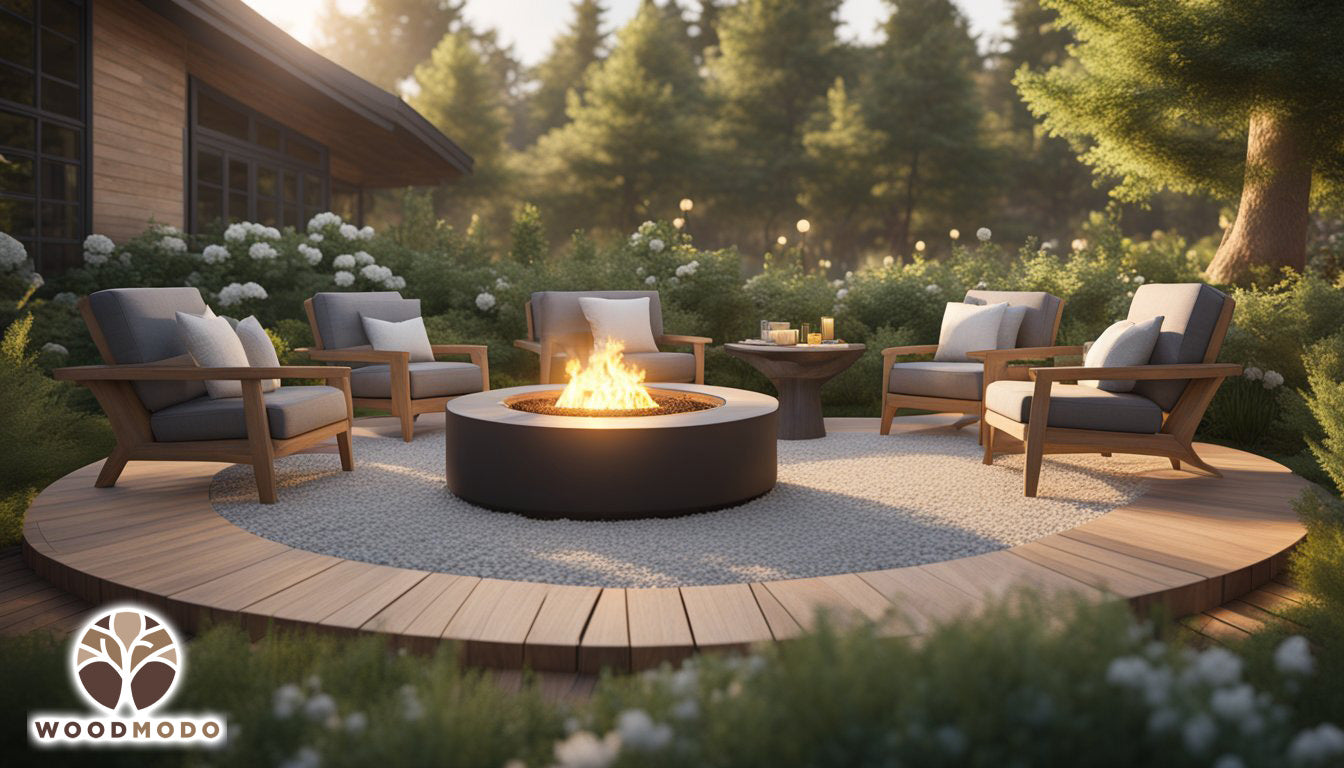
As the weather warms up, you might be contemplating which fire pit design to introduce to your outdoor space. Here’s a look at various types, each with its unique flair and functionality.
Fire Bowls
Fire bowls are the quintessential outdoor fire feature, offering a simple yet versatile design. They typically have a wide, open top and come in a variety of materials like steel or concrete.
Fire Tables
Imagine a fire pit and a patio table combined, and you've got a fire table. These pieces are fantastic for entertaining, as they provide both warmth and a place to set your drinks. Designs range from long, elegant tables with a fire feature running down the center to more compact, square options for cozier arrangements.
Chimineas
Chimineas present a traditional look with their pot-bellied body and chimney top. They're ideal for directing smoke upwards, making them a suitable choice if you prefer a fire pit that minimizes smoke drifting towards you and your guests.
Fire Rings
If you're after the classic campfire feel, a fire ring might be the right pick for you. Usually made of metal, these rings contain the fire in a designated area and often feature decorative cut-outs. They're portable and excellent for a no-frills, authentic fire experience.
Tabletop Fire Pits
For small spaces or a touch of elegance, tabletop fire pits are your go-to. These petite versions bring the fire pit experience to even the smallest of outdoor areas. They're perfect for those intimate evenings where just a flicker of flame is enough to set the mood.
Materials and Construction
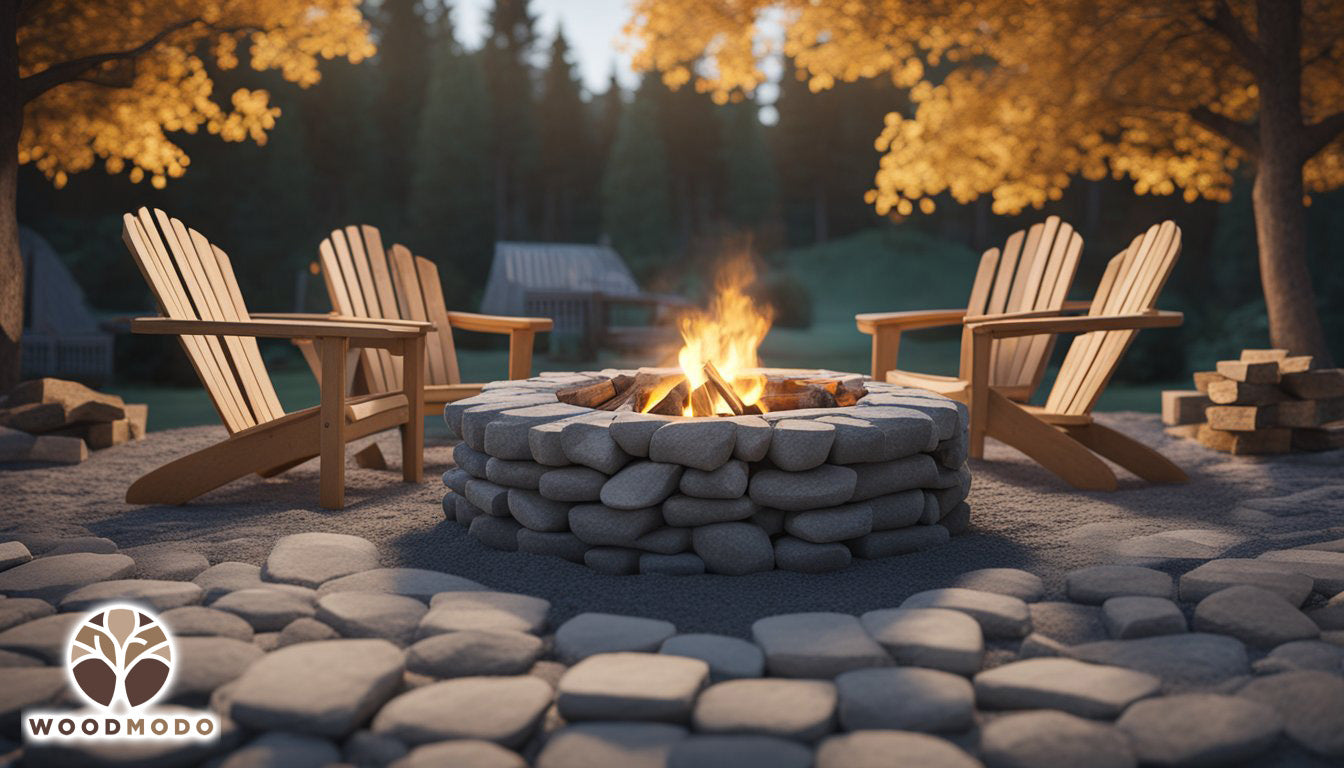
The choice of material not only affects the appearance but also the durability and maintenance requisites of your fire pit. Each material offers different benefits, whether it's the rustic charm of stone or the sleek finish of metal.
Stone Fire Pits
Stone fire pits are loved for their natural aesthetic. You’ll find options like flagstone, limestone, and stacked stone, each providing a unique look. Stone is heat-resistant and durable, boasting a long lifespan with proper care. Typical stone fire pits are often custom-built, enhancing the existing landscape design of your outdoor area.
Metal Fire Pits
A metal fire pit is versatile and available in a variety of styles. Common materials include:
- Steel: Often coated to prevent rust and able to handle high temperatures.
- Cast iron: Heavy and durable with excellent heat retention.
- Copper: Develops a beautiful patina over time and withstands elements well. Metal pits can be portable and often come in various shapes, from bowls to squares.
Concrete Fire Pits
Concrete fire pits are known for their modern look and structural solidity. They are often pre-cast or poured in place, allowing for a variety of customizable shapes and sizes. Concrete is exceptionally durable and can handle exposure to the elements, though it may be susceptible to cracking in extreme temperatures.
Ceramic Fire Pits
Finally, ceramic fire pits, commonly known as chimineas, have a distinct design with a rounded bottom and vertical chimney. They are typically made from terracotta but may also be found in other glazed and unglazed ceramics. These fire pits provide excellent heat direction but can be fragile compared to other materials.
Safety Considerations

When setting up your fire pit, safety is the cornerstone of a worry-free experience. Here's how you can ensure a safe environment while enjoying the warmth of your outdoor fire pit.
Placement and Clearance
Your fire pit needs to be on a stable, non-combustible surface with ample clearance. Make sure there's a minimum of 10 feet of distance between the fire pit and any obstructions or structures, including patio coverings, to prevent the spread of fire.
-
Recommended Clearance:
- Above: At least 21 feet from overhanging branches,
- Around: Minimum 10 feet from buildings or fences,
- Below: Place on non-flammable surfaces like stone, brick, or concrete.
Fire Pit Screens
Utilize fire pit screens to keep embers contained and to reduce the risk of sparks escaping. Choosing a screen that fits securely over your fire pit is essential for both wood-burning and gas fire pits.
-
Benefits:
- Containment: Prevents embers from escaping,
- Protection: Shields against accidental contact with flames.
Operating Guidelines
Before lighting your fire pit, always inspect it for any damage or debris. Use only dry, seasoned wood for wood-burning pits and ensure the gas components of propane or natural gas pits are clear from obstructions.
-
For wood-burning pits:
- No flammable liquids to start the fire
- Extinguish thoroughly after use
-
For gas fire pits:
- Regularly check the burner and gas lines
- Cover when not in use to protect from the elements
Accessories and Features
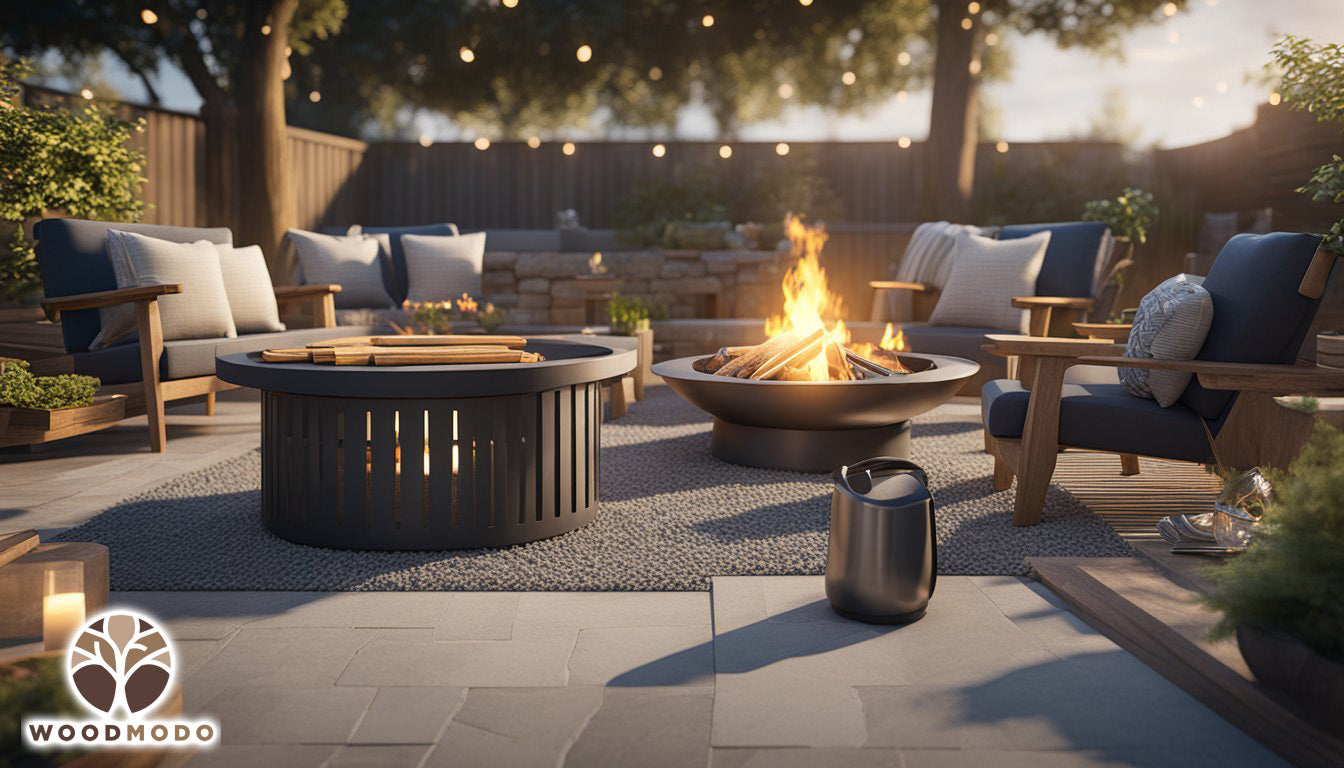
Enhance your fire pit with the right accessories and features to create a more functional and enjoyable outdoor space. Let's explore some specifics that can elevate your fire pit experience.
Grills and Grates
Your fire pit can double as a cooking area with the addition of grills and grates. These allow you to grill burgers, roast hot dogs, or even cook a pizza if you're feeling adventurous. They can fit on top of your fire pit and handle various cooking instruments like griddles, grills, and woks.
Covers
To protect your fire pit from the elements, a cover is essential. It keeps out rain, leaves, and debris when the fire pit is not in use. A sturdy cover not only prolongs the life of your fire pit but also ensures it's always ready for your next gathering.
Seating Arrangements
No fire pit is complete without a comfortable seating arrangement. Options range from heated camping chairs for a cozy warmth to simple yet stylish benches that complement the pit's design. Seating should be placed at a safe distance from the fire while allowing you and your guests to enjoy the warmth and ambiance.
Maintenance Tips

Proper maintenance is crucial to ensure your fire pit remains a safe and cozy centerpiece for your outdoor living space. Here's how to keep it in top condition all year round.
Cleaning and Care
After using your fire pit, wait at least 24 hours for it to cool completely before cleaning. Remove ashes and debris to prevent corrosion and accumulation, which is essential for fire pits made from metal. Regularly inspect for cracks or weaknesses, particularly if you have a stone or brick fire pit.
- Metal fire pits: Wipe with a damp cloth and mild detergent. Coat with a light layer of oil to prevent rust.
- Stone or brick pits: Brush off debris and use a gentle detergent for any soiled areas. Avoid strong acids that may damage the stone.
Storage and Protection
Keep your fire pit functioning well with these protection tips:
- Cover your fire pit: Use a waterproof and UV-resistant cover to shield it from the elements when not in use.
- Portable fire pits: Store in a dry, covered area away from moisture to prevent rust and weathering.
DIY vs. Professional Installation
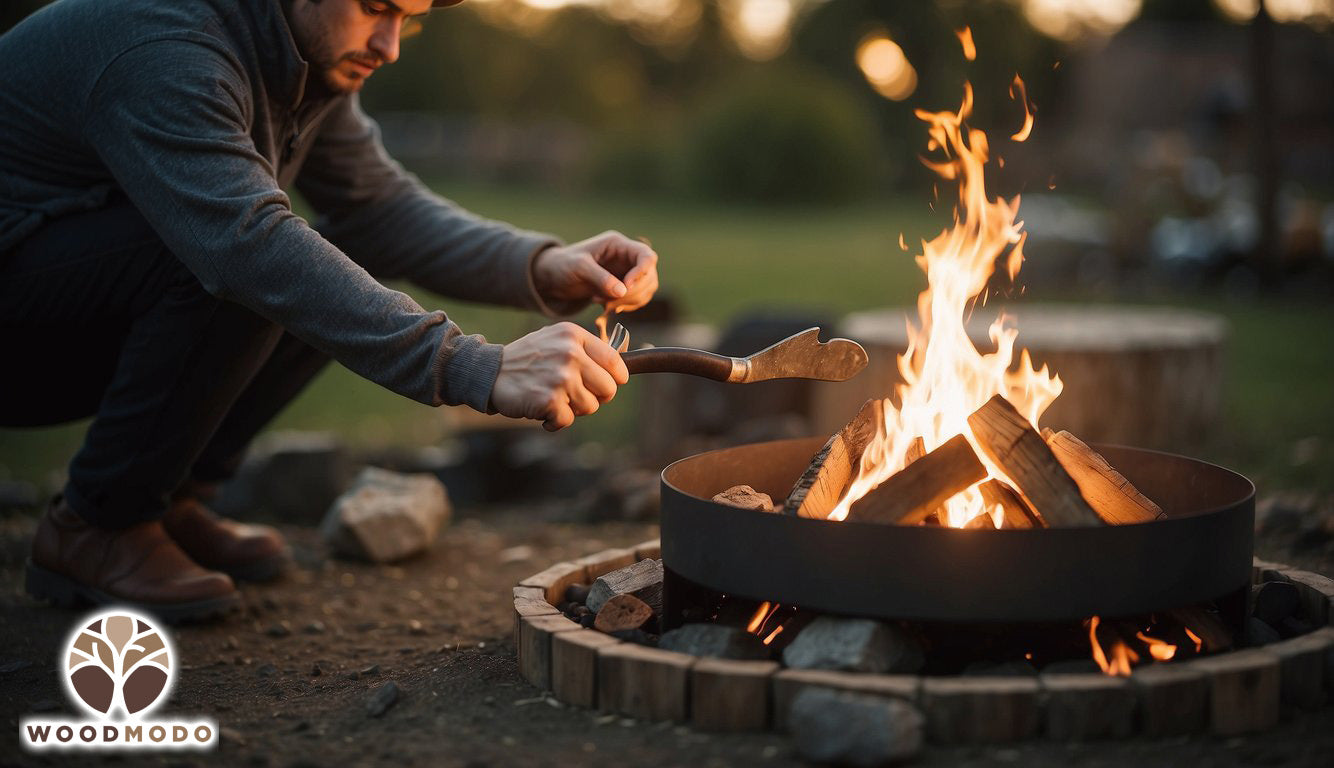
When you're ready to add a fire pit to your outdoor space, you need to decide between a do-it-yourself approach or hiring a professional. Your choice will impact the cost, time investment, and customization level of your fire pit project.
DIY Fire Pit Kits
DIY Fire Pit Kits often provide a cost-effective and satisfying option if you're handy and have some basic construction skills. Here are some specifics:
- Cost: Generally, you'll save money on labor, with kits ranging from $200 to $1,000.
- Time: Setting up a kit can take anywhere from a few hours to a full day, depending on the complexity.
- Customization: While kits come in various designs, your customization options can be limited to what's available in the kit.
Pros:
- Cost savings on labor
- Personal satisfaction from completing a project
Cons:
- Limited designs
- Potential challenges with installation
Hiring a Professional
Opting to Hire a Professional can increase the cost of your fire pit, but it also offers significant benefits in terms of design and hassle-free construction:
- Cost: Professional installations can range from $300 to $3,000, depending on materials and design.
- Time: The time frame for professional installation will vary but often is quicker than DIY since experts are at work.
- Customization: Professionals can offer a wider range of custom designs beyond kit limitations.
Pros:
- Expertise in installation
- More design options and custom solutions
Cons:
- Higher overall cost
- Scheduling and availability of contractors
Selecting the Right Fire Pit
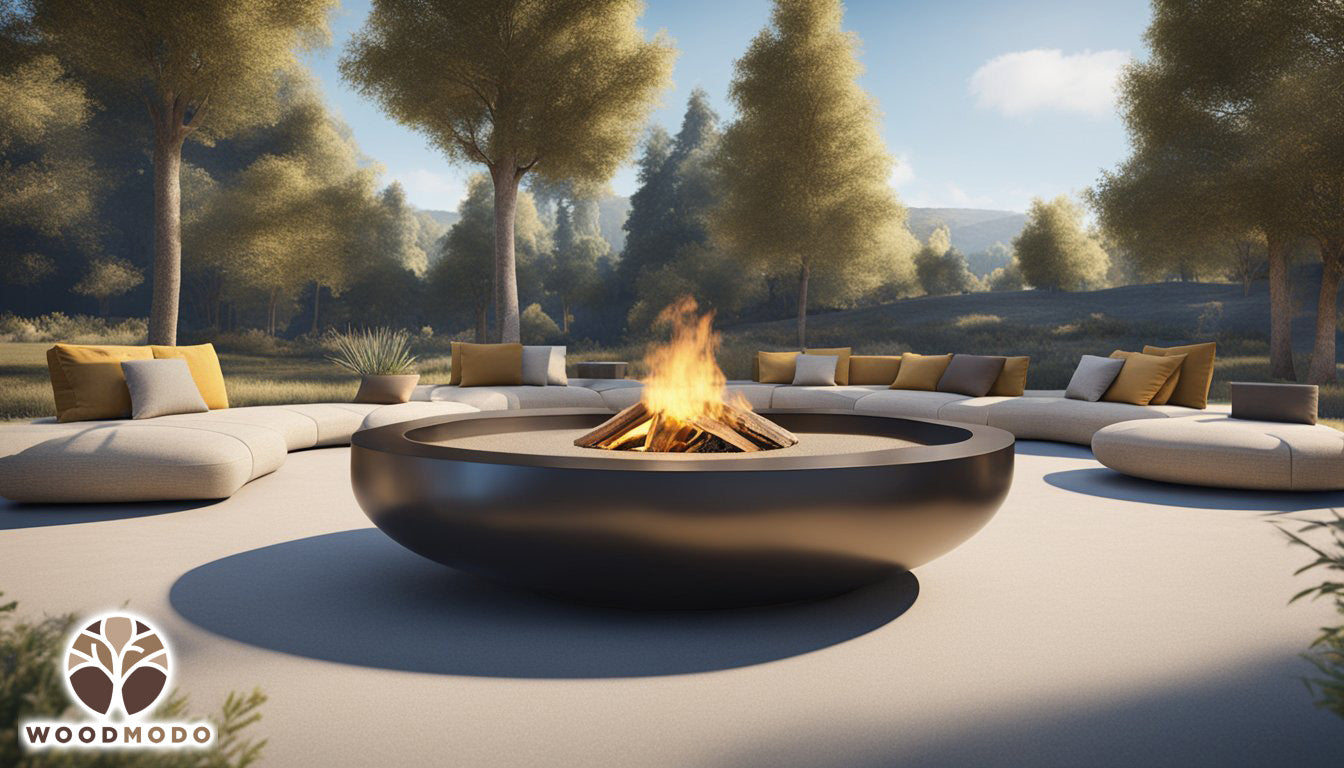
With warmer weather on the horizon, it's the perfect time to finish your outdoor oasis with the addition of a fire pit. But choosing the right one for you involves considering size, style, and budget.
Size and Space Requirements
When it comes to fire pits, the size of the unit and the space available in your yard are key factors. An above-ground fire pit typically stands 12 to 14 inches tall. If you plan to occasionally use the fire pit as a footrest, consider a shorter height of about 6 to 12 inches. Ensure there's sufficient clearance around the pit, not only for seating but also for safety.
Style and Aesthetics
Your fire pit should complement your outdoor decor. From wood-burning pits that offer a traditional campfire feel to decorative stone or brick enclosures, the options are abundant. The style you choose can either be a focal point or blend seamlessly with your existing outdoor furnishings.
Budget Considerations
Budget is an important consideration since fire pit costs can vary widely. A simple metal ring might suffice if you're looking for a cost-effective solution, while a sturdy, smokeless model could be a higher investment with added benefits. Be sure to account for any additional accessories, such as protective mesh lids or grill grates and fuel which can also affect the overall price.

